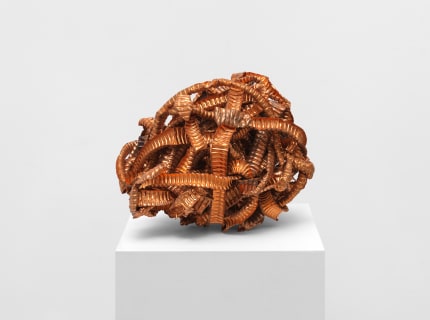Hassan Sharif
Alexander Gray Associates presented recent work by Hassan Sharif (b.1951), featuring sculptures and woven assemblages. Recognized as a pioneer of conceptual art and experimental practice in the United Arab Emirates over the past four decades, Sharif has transgressed traditional frameworks for art making by extending his practice to performance, installation, drawing, painting, and assemblage that integrates ordinary objects as the primary medium. The tapestry-like works in this exhibition are conceptually linked by their relationship with the human body and social structures.
After familiarizing himself with the ideas of Dada and Fluxus art during his studies in the early 1980s at Byam Shaw School of Art in London (now Central Saint Martins College of Arts and Design), Sharif created performance-based works that engaged with repetition, landscape, and the body, themes that he has continued to explore throughout his practice. Sharif first incorporated weaving into his art making process as a part of his “Objects” series (1982–present) as a means of critically exploring the increasing modernization and industrialization occurring in the U.A.E. For this series he sources inexpensive and mass-produced goods that he buys at local markets in his native Dubai to create artworks. By cutting, bending, grouping, and braiding these cultural artifacts, the artist sheds their functionality to enhance their aesthetic and political significance. For him, “the work is about consumerism. I use cheap materials, ordinary things that are readily available in the market.” Sharif is simultaneously a consumer, and a producer, who says “I’m imitating consumers, but I’m using the materials to make art.” By weaving together, in the ancient tradition of tapestry making, ordinary objects consumed by today’s society, Sharif points both to the hyper-industrialization impacting everyday life and the abandonment of old traditions that were key to building strong bonds among the members of communities in the past. On his interest in unifying aspects of both the ancient and modern, the artist explains “I want to nurture new ways out of the old and present these in a contemporary visual and artistic context.”
In Sharif’s body of work, the rhythmically repetitive act of weaving echoes the involuntary functions of the human body, such as swallowing, breathing, and blinking. At the same time, the materials deployed to create the works in this exhibition, including combs, nail clippers, masks, and gloves are traditionally used to modify or cover the body.
Recently, Sharif has centered his production around large-scale wall sculptures that incorporate objects that as he describes, “people depend on greatly to keep up with their daily routines and activity. So long as they are alive, they keep using, exhausting, and relying on them as if they are, in one way or another, part of their own bodies.” In Masks (2016), Sharif creates a grid of many colored face masks which cascade towards the floor, tied to one another by their black ribbons to ultimately form an irregular fringe at the bottom of the sculpture. The artists notes that masks have “an important historical role. In the Middle East, women cover their faces with veils. In Africa [masks are] used in dances to ward off evil spirits. Hiding one’s identity has become increasingly important.” For Ladies and Gentlemen (2014), he assembled mass-produced and inexpensive female and male shoes, into a drape-like object that emphasizes seriality and the dislocation of functional objects. His use of shoes speaks to an interest in sexual politics across centuries and geographies; in the work, men and women occupy a common space, and are bound together with hand-painted papier maché and ropes. In this way, he refers to the intrinsic connection between individuals and society.
Sharif’s interest in visual accumulation, and in systematic production, calculations, and geometric permutations are apparent in his choice of material for Combs (2016). For this work, he assembled plastic combs in a variety of bright colors, which jut out from the wall at irregular angles creating a haphazard visual rhythm. For the artist, combs, widely used to tidy hair, exemplify the use of logic necessary in mass-production of consumer goods. As he explains, “the number of teeth, the distance between them, their length and thickness, all seem to be well calculated, and they have been so for thousands of years.” Sharif echoes the geometric precision of the combs by organizing them in a meticulous gridded pattern in space, following a calculated mathematical model of his own invention, to create a hanging tapestry.


